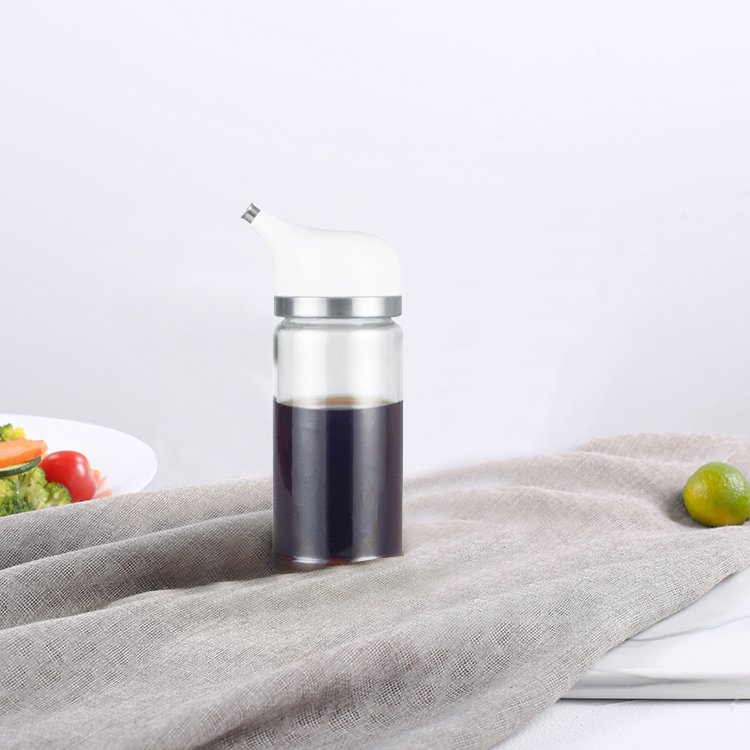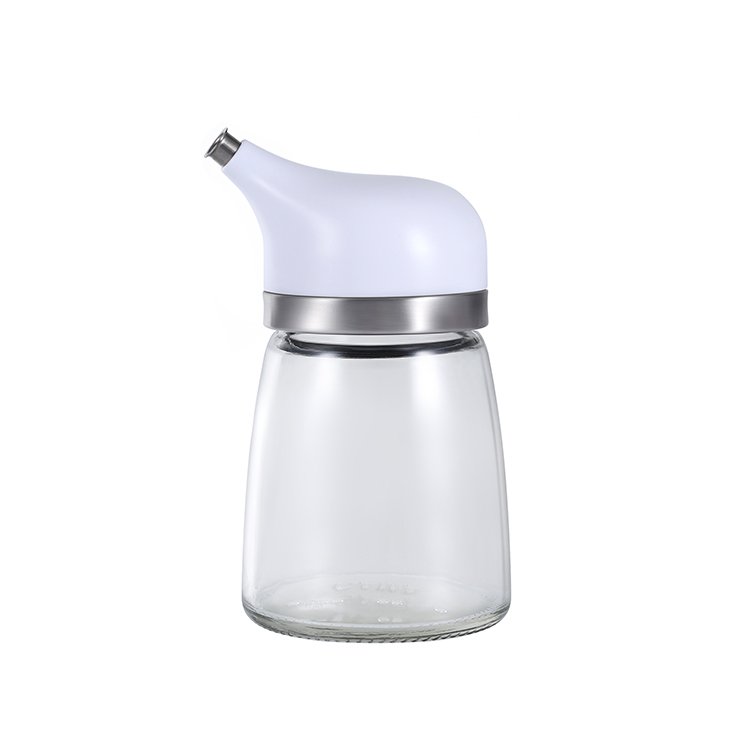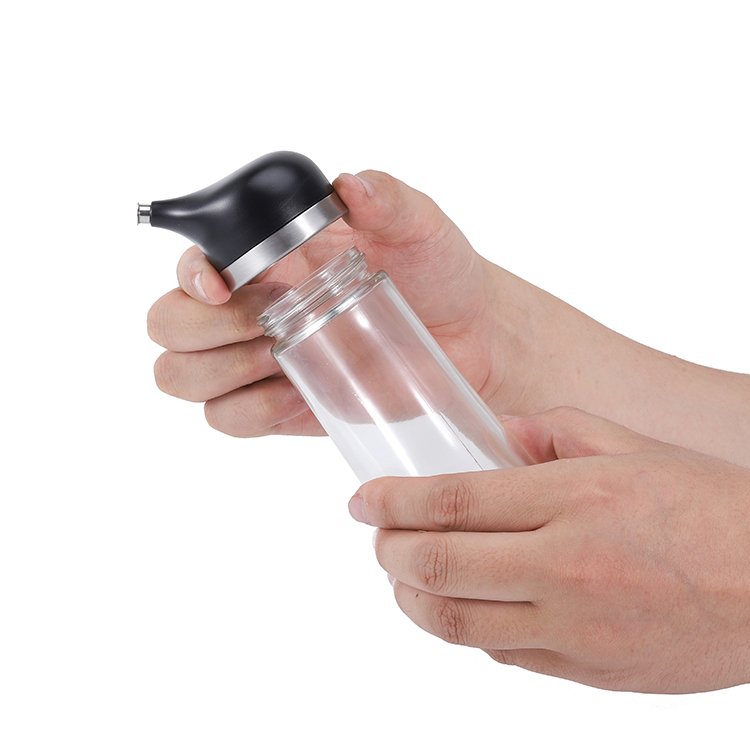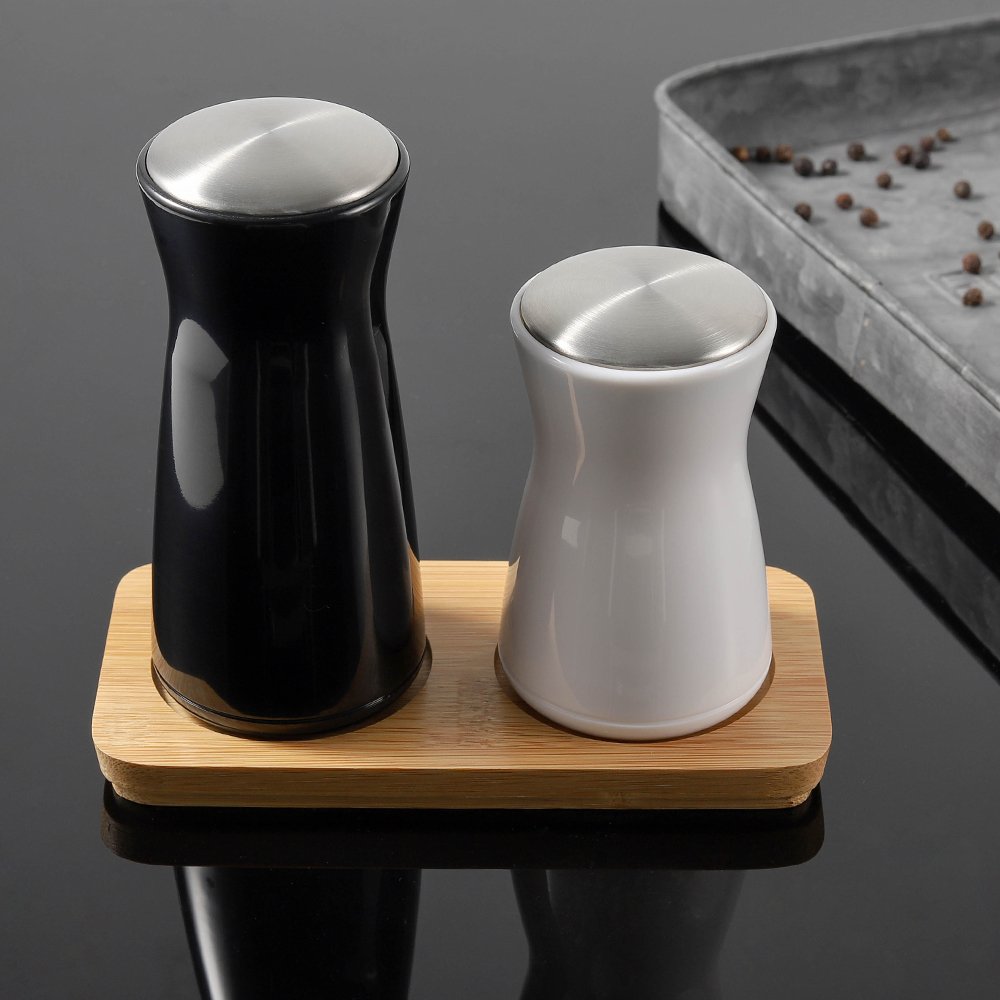
Note: An olive oil and vinegar dispenser can be a great tool in any kitchen. You might want a non drip oil dispenser if you hate messy countertops and want precise pouring.
The real value of an olive oil dispenser bottle depends on your priorities. You must balance the daily convenience of a clean kitchen against the potential hassles of cleaning. The initial cost of the olive oil dispenser is another factor, making it a great—but not perfect—solution for everyone.
The Pros: Why You Might Love a No-Drip Oil Dispenser

If you’re tired of the daily annoyances that come with standard oil bottles, an oil dispenser can feel like a kitchen game-changer. You might find that the benefits go far beyond just a cleaner counter. Let’s explore the four biggest advantages.
Pro 1: Say Goodbye to Oily Rings
You know the scene all too well: a sticky, greasy ring on your countertop or a slippery film on the outside of your cooking oil bottle. Standard bottles often have loose lids and poor seals, leading to constant dripping and spilling. This not only creates a mess but can also make the bottle awkward and unsafe to handle. Some glass bottles are even prone to breaking, creating a major hazard.
A well-designed oil dispenser eliminates this problem entirely. The magic lies in the spout design.
How does it work? 💡
A smart spout allows air to enter the bottle while you are pouring. This airflow, often combined with a funnel-like shape, creates a clean cutoff and stops that last drop of oil from running down the side. This simple mechanism provides excellent drip prevention, keeping your hands and surfaces clean.
Pro 2: Achieve Perfect, Controlled Pouring
Have you ever tried to lightly drizzle oil over a salad, only to have it gush out of the bottle? A standard bottle offers almost no pour control, making precise measurements nearly impossible. This can be a problem for both your recipes and your health. As one expert noted:
“People don’t realize how many calories they add and tend to undercount any oil they add to the dish.”
A quality oil dispenser gives you complete command over the oil flow. Advanced designs provide a steady, controlled stream for perfect pouring every time. This flow control is crucial for several cooking tasks:
- Dressing Salads: Achieve a delicate, even coating instead of a soggy mess.
- Sautéing: Add just the right amount of oil to the pan, preventing food from getting greasy and helping you maintain the proper cooking temperature.
- Portion Control: Easily manage your oil consumption for healthier meals.
Features like ergonomic grips and handy measurement scales further enhance your control, helping you pour with confidence and reduce waste.
Pro 3: Keep Your Cooking Oil Fresher, Longer
Cooking oil, especially extra virgin olive oil, does not last forever. Its two biggest enemies are oxygen and light. When oil is exposed to air and light, a process called oxidation begins. This process breaks down the fats in the oil, leading to several problems:
- It develops a rancid taste and an unpleasant smell.
- It loses nutritional value.
- It can even form potentially toxic compounds.
A standard, poorly sealed bottle constantly exposes your oil to air, speeding up this degradation. A high-quality olive oil dispenser is designed to protect your investment. Many feature airtight lids that prevent oxygen from getting in, preserving the oil’s taste and nutritional benefits. This is key for maintaining oil freshness. To combat light, look for an oil dispenser made from protective materials like stainless steel or dark, opaque glass. Some even use special ultraviolet glass that blocks harmful light rays, keeping your oil fresh for months longer.
Pro 4: Upgrade Your Kitchen’s Style
Your kitchen tools should be functional, but they can also be beautiful. A clunky plastic oil bottle rarely adds to your kitchen’s decor. A stylish no drip oil dispenser, on the other hand, can be a statement piece. Today, you can find an olive oil dispenser to match any aesthetic.
| Style | Description |
|---|---|
| Minimalist | Sleek designs with clean lines in neutral colors like black, white, or gray. |
| Eco-Friendly | Made from sustainable materials like bamboo, recycled glass, or ceramic. |
| Modern | Polished stainless steel offers a sophisticated, rust-resistant look. |
| Bold | Vibrant colors and unique geometric shapes that act as a focal point. |
Many modern dispensers have won prestigious design awards for their blend of beauty and function. You can even find matching oil and vinegar sets that create a cohesive, organized look on your counter or table, adding a touch of personality and charm to your kitchen.
The Cons: Potential Downsides of an Oil Dispenser
While an oil dispenser can solve many kitchen frustrations, it’s not without its drawbacks. You should consider the potential downsides before you decide to buy one. The convenience of a clean counter sometimes comes with a trade-off in maintenance and cost.
Con 1: The Cleaning Can Be a Chore
An oil dispenser requires regular cleaning to stay functional and hygienic. Old oil residue can become sticky, clog the spout, and even turn rancid, affecting the taste of your fresh oil. Unfortunately, cleaning an oil dispenser isn’t as simple as rinsing it out. The process can be quite involved.
Here is a typical cleaning routine you might follow:
- For a new oil dispenser, you can start with a simple water rinse.
- For regular cleaning, add a degreasing soap to the bottle. Then, carefully pour in hot water.
- If the oil is thick, you may need to let the soap and water mixture sit for a while.
- Add a small amount of vinegar and swirl it to help restore the glass’s shine.
- Rinse the dispenser thoroughly with warm water.
- You must let the oil dispenser dry completely before refilling it. Any remaining water can spoil your oil.
A Word of Caution ⚠️
You must be careful with temperature changes, especially with glass models. Pouring cold water into a hot dispenser, or placing a hot dispenser on a cold surface, can cause the glass to crack or shatter.
Con 2: Not All Dispensers Are Truly “No-Drip”
The main selling point is the “no-drip” feature, but not every product delivers on this promise. A poorly designed no drip oil dispenser can be just as messy as the bottle it replaced. Leaks and drips often stem from specific design flaws. Common issues include loose spout connections, worn-out seals, or a clogged air-return hole that disrupts the smooth flow. A faulty valve can also cause a slow, continuous trickle.
While many high-quality brands like OXO and Emile Henry receive praise for their excellent drip resistance, lower-quality models often fail to perform. You might find that a cheap oil dispenser creates the very oily puddles you were trying to avoid. Your success depends heavily on choosing a well-engineered product.
Con 3: Material and Durability Concerns
The material of your olive oil dispenser affects its look, durability, and ability to keep oil fresh. Each option comes with its own set of pros and cons.
| Material | Pros | Cons |
|---|---|---|
| Glass | You can see the oil level; it does not affect flavor. | It is fragile and can break; clear glass exposes oil to light. |
| Stainless Steel | It is very durable and protects oil from light. | You cannot see the oil level; it shows fingerprints easily. |
| Ceramic | It offers great light protection and comes in many styles. | It can chip or break easily and can be heavy. |
| Plastic | This material is lightweight, durable, and affordable. | It may absorb odors and potentially leach chemicals into the oil. |
Beyond the main body, the spout itself can be a point of failure. Common durability issues include spouts that leak around the seal, become clogged, or detach from the bottle entirely. A cheap olive oil dispenser might have a seamed bottom that can start leaking over time, creating what some users call a “leaky nightmare.” The quality of the materials directly impacts the longevity and performance of your oil dispenser.
Con 4: Upfront Cost and Smaller Capacity
A high-quality oil dispenser is an investment. While you can find budget options, the models that perform best often come with a higher price tag. You are paying for better design, superior materials, and reliable pouring performance. This upfront cost can be a barrier if you are used to just using the bottle the oil comes in.
Additionally, most dispensers have a smaller capacity than the large tins or bottles you buy from the store. A typical olive oil dispenser might hold 12 to 17 ounces. This means you will need to refill it more frequently. This regular refilling adds another small task to your kitchen routine. You must decide if the benefits of controlled pouring and a cleaner kitchen are worth the extra cost and effort.
The Verdict: Who Should Get an Olive Oil Dispenser?
You have weighed the pros and cons. Now, you must decide if an oil dispenser is right for your kitchen. The answer depends on your personal cooking style and priorities. Let’s break down who benefits most from this tool.
Yes, If You’re a Kitchen Neat-Freak
If you constantly wipe up oily rings and hate the feeling of a sticky bottle, a quality oil dispenser is a must-have. You value a clean and organized workspace. The daily frustration of a messy counter outweighs the occasional task of cleaning a dispenser. This simple tool keeps your counters and hands clean, giving you more control and less mess every time you cook. For you, an olive oil dispenser is a practical solution to a daily annoyance.
Yes, If You Value Kitchen Aesthetics
Your kitchen is more than just a place to cook; it is a reflection of your style. A generic plastic bottle can disrupt your decor. An olive oil dispenser, however, can be a stylish accessory. You can choose an oil dispenser that matches your kitchen’s look, turning a functional item into a design element.
| Dispenser Type | Aesthetic Contribution | Best For |
|---|---|---|
| Glass Cruet | Transparent, showcases oil color and clarity | Casual home cooking and table presentation |
| Stainless Steel | Contemporary, sleek, suits modern kitchens | Preserving oil freshness, modern decor |
| Ceramic Cruet | Stylish, unique finish, decorative | Decorative kitchens and rustic settings |
This makes the oil dispenser a functional and beautiful addition to your countertop.
No, If You Prefer Low-Maintenance Simplicity
On the other hand, an oil dispenser might not be for you. If you dislike extra chores and prefer the most straightforward approach, stick with the original bottle. The process of decanting, cleaning, and drying an oil dispenser can feel like a burden. You might prefer the simple routine of using the oil straight from its original bottle and recycling it when it’s empty. For you, convenience means fewer tools to manage.
How to Find the Best Olive Oil Dispensers: A Quick Guide

You are ready to find the perfect oil dispenser for your kitchen. Finding the best olive oil dispensers involves looking at a few key features. This quick guide will help you choose a model that is clean, convenient, and durable.
Check the Spout Design for a Drip-Free Pour
The spout is the most important feature for preventing messes. You should look for smart designs that guarantee a clean cutoff after each use. Some of the best olive oil dispensers use drip-free spouts with a folded lip. This design stops the flow of oil cleanly. Other top picks feature weighted spouts. These have a small flap that opens for pouring and closes automatically when upright. This mechanism also keeps dust out of your oil. For the best pour control, find an oil dispenser with a separate air intake hole. This feature ensures a smooth, continuous stream for perfect pouring. Some premium models even have drip return systems that catch any extra oil, making them truly mess-free.
Prioritize Models That Are Easy to Clean
An oil dispenser needs regular cleaning to work well. You should choose a model that is easy to clean. A wide-mouth opening makes it simpler to add soap and water. Using a bottle brush can also help you scrub the inside of any oil dispenser. Some top picks are even dishwasher-safe, which simplifies the process.
Pro Tip 💡
Look for an olive oil dispenser that you can take apart easily. This makes cleaning every part much simpler.
| Model | Dishwasher-Safe | Easy to Disassemble |
|---|---|---|
| Chefshere Precision Pour Glass Dispenser | Yes | N/A |
| Chefshere Gravity Oil Vinegar Dispenser | Yes | N/A |
| Kitchenmaiden 2-in-1 Oil Dispenser | N/A | Yes |
Choose High-Quality, Food-Safe Materials
The material of your oil dispenser affects both durability and oil freshness. You should always choose high-quality, food-safe materials.
- Glass: This is an excellent choice. Modern borosilicate glass is naturally BPA-free and does not contain lead. To protect your oil from light, choose dark amber or green glass. Amber glass blocks over 95% of harmful UV rays.
- Stainless Steel: This material is very durable and offers perfect protection from light.
- Plastic: You should avoid plastic. It can absorb odors and may shed microplastics into your food.
A quality material ensures your oil stays fresh and your pouring experience remains safe and enjoyable.
A no drip oil dispenser trades occasional cleaning for a daily reward. This oil dispenser offers a mess-free, controlled cooking experience. Ultimately, you must decide if this olive oil dispenser is right for you.
Is a clean counter from a no drip oil dispenser worth the extra maintenance of the oil dispenser?
FAQ
How often should you clean an oil dispenser?
You should clean your dispenser every few months or each time you refill it. Regular cleaning prevents clogs and keeps your oil tasting fresh and pure.
Can you use an oil dispenser for other liquids?
Yes, you can use it for other liquids. Many people use dispensers for vinegar, soy sauce, or even dish soap.
Remember 💡
Always clean the dispenser thoroughly between uses to prevent mixing flavors or residues.
What is the best way to fill an oil dispenser?
You can easily fill your dispenser without a mess. Use a small funnel to guide the oil directly into the bottle. This simple tool makes refilling quick and clean.






